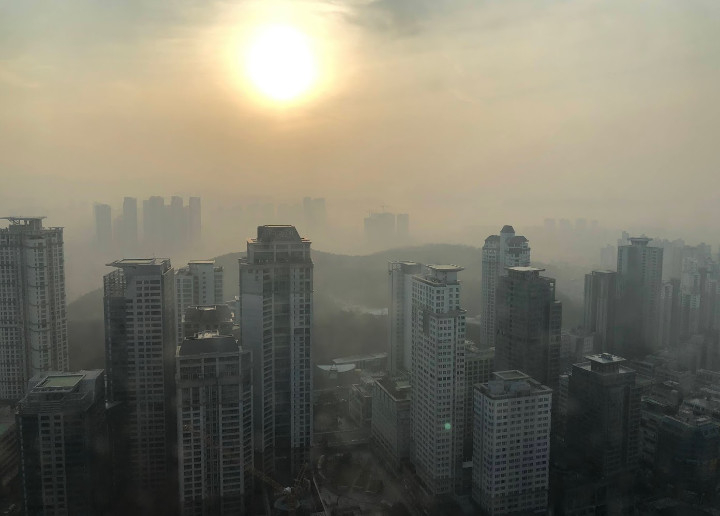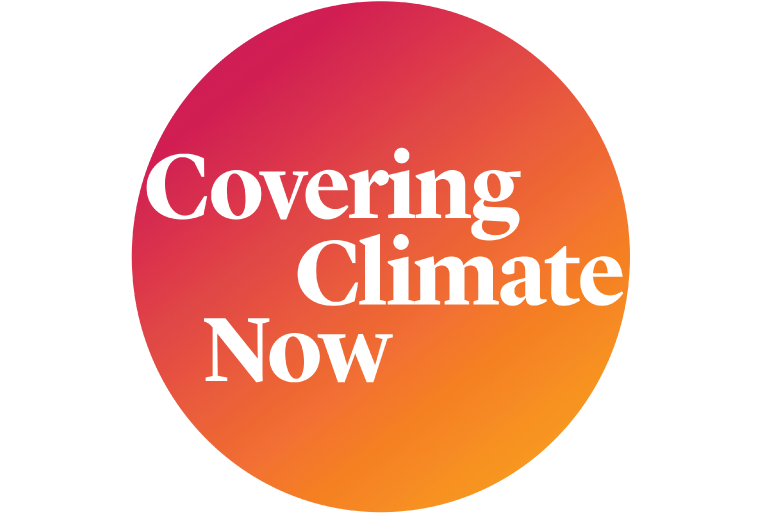Sign up for the daily CJR newsletter.
Editor’s note: This column, part of Covering Climate Now, is published in collaboration with the Korea Press Foundation. The February issue of KPF’s Newspaper & Broadcasting magazine digs into how journalists everywhere are covering the climate story and how that coverage might improve. Learn more about KPF here and check out their full February issue, in Korean, here.
When covid-19 struck in 2020, news outlets around the world rapidly transformed to meet the moment. Some changes were practical necessities: social-distanced interviews became the norm, and print teams retooled to produce newspapers and magazines remotely. Other changes were creative in nature, aiming to help audiences grapple with the scope of the pandemic and its consequences. On Web homepages, modules tracking infections became fixtures. Outlets terminated long-standing paywalls, to help ensure accurate coronavirus information was widely available. And not a few newsrooms experimented with new formats and surprising graphics to arrest audiences’ attention; in May 2020, for example, as covid-19 fatalities in the United States approached 100,000, the New York Times ran a striking front page filled with victims’ names, calling their deaths “an incalculable loss.”
As devastating as the coronavirus pandemic has been, it’s tragically only a preview of the chaos that the climate crisis has in store. Yet, historically, journalism’s response to climate change has been comparatively muted. For many years, news organizations treated the climate as only a niche concern. To appear “objective,” they indulged climate denial, pitting established science against provably false arguments by the fossil fuel industry and its defenders. As the crisis grew worse, and as inaction remained the norm from world leaders, outlets defended their own inaction with outdated claims that audiences simply weren’t interested in climate change.
Thankfully, that’s all starting to change. In recent years, newsrooms across the world have announced fresh commitments to the climate story, hiring scores of reporters and launching a diverse array of climate desks and programming. At Covering Climate Now, a global journalism nonprofit cofounded in the US by the Columbia Journalism Review and The Nation, we’re proud to have played a humble part in this evolution. We started in 2019, dedicated to the belief that stronger climate reporting was needed to help save a world on the brink. Along with our partners—which hail from more than fifty countries and include many of the biggest names in news, like Reuters, Bloomberg, and Al Jazeera—we’ve worked to identify and spread climate coverage best practices. We offer a range of journalistic resources and we highlight great work where we see it, so that journalists everywhere can learn by example.
More hard work remains to be done, of course. If anything, the cascade of climate-change-fueled disasters in 2022 further emphasized the urgent need for excellent climate journalism.
According to Europe’s Copernicus Climate Change Service, last year was the fifth hottest ever recorded, with eight of the planet’s ten hottest years having come in the past decade. Our oceans, too, are hotter than ever—which lays the groundwork for more powerful hurricanes and typhoons—and sea ice at the poles is at all-time lows. Throughout 2022, monster heat waves engulfed swaths of Europe, India, and China; prolonged drought in East Africa gave way to deadly food and water shortages; and unprecedented flooding in Pakistan left a staggering one-third of the country submerged. Scientists are unequivocal that climate change is making weather-related disasters like these worse. And the disasters’ human consequences are impossible to deny. The United Nations estimates an average of 25.1 million people are forced out of their homes every year due to extreme weather; in 2021, it was 59.1 million people, which one UN expert described as “an intolerable tide” of displacement.
World leaders, finally, seem to be getting the memo. Beyond disasters, last year saw many promising developments, including, not least, major climate legislation from the US, the world’s largest historical emitter of greenhouse gases. As the disappointing outcome of November’s cop27 climate summit in Egypt demonstrated, though—a breakthrough deal to compensate poorer countries for climate damage notwithstanding—the world’s most powerful countries remain more talk than action. “The world still needs a giant leap on climate ambition,” UN secretary-general António Guterres said at the summit’s conclusion.
As humanity strives for better, journalists have an indispensable role to play. For one, we’re needed to hold leaders accountable for their lofty climate pledges, a charge that goes for emissions-heavy corporations as much as for governments. We’re also needed to educate our audiences, not just about the dangers of failing to cut emissions but the hope and promise of climate solutions.
Like with covid-19, these tasks call for better than journalism-as-usual. Indeed, despite the leaps-and-bounds improvements news organizations have made, climate change is still dramatically under-covered, relative to the size of the problem. In a December study by the Reuters Institute at Oxford University, roughly half of news consumers in eight diverse countries said they hadn’t seen or heard any news about climate change in the past week; for others, it had been much longer. Better climate coverage isn’t only a matter of more coverage, however. To do the climate story justice, we’ll need big ideas and outside-the-box thinking.
On this front, several outlets are setting encouraging examples. In the UK, The Guardian, which serves as Covering Climate Now’s lead news partner, last year issued its own robust “climate pledge,” promising not just to keep up its standard-bearing climate reporting but to fully decouple its business and finances from fossil fuel companies (the newspaper already stopped accepting fossil fuel advertising in 2020) and to slash its emissions by two-thirds by 2030. The Bloomberg offshoot Bloomberg Green operates an impressive “data dashboard” that aims to capture the state of climate change with up-to-the-minute facts and figures, similar to the market statistics that are hallmarks of business reporting. And in Japan last year, dozens of news organizations, including top newspapers and TV stations, set aside competition to participate in a campaign called “Promise of 1.5 degrees: Act now to stop global warming”; the joint effort aimed to explain the critical importance of the world’s goal to limit global temperature rise to 1.5 degrees Celsius above preindustrial levels, as well as the behaviors that organizations and everyday citizens could change to do their part.
The language journalists use also merits thoughtful reconsideration. In 2019, The Guardian updated its style guide “to introduce terms that more accurately describe the environmental crises facing the world.” Specifically, the newspaper instructed journalists that “climate crisis” and “climate emergency” would be preferred above the less urgent “climate change.”
“The phrase ‘climate change’ sounds rather passive and gentle when what scientists are talking about is a catastrophe for humanity,” Guardian editor in chief Katharine Viner explained.
Thousands of scientists around the world, in fact, have said—in peer-reviewed journals and elsewhere—that we face a “climate emergency” and, worse, that it’s accelerating faster than they historically predicted. Consequently, Covering Climate Now, in 2021, issued a statement, signed jointly by some of our top partners, calling on outlets everywhere to follow The Guardian’s lead in recognizing that “the climate emergency is here.” The word “emergency,” we wrote, conveys both the need for immediate action and the fact that the time to act is running short. Dozens of newsrooms worldwide have since added their outlet’s name to Covering Climate Now’s statement.
To be sure, there’s good evidence that stronger wording like this will resonate with audiences. A recent survey by the UN Development Programme, for example, which polled 1.2 million people in more than fifty countries, found that two-thirds of the world’s citizens believe climate change constitutes a “global emergency.”
That said, journalists shouldn’t give audiences the impression that all is lost. We want to describe the climate threat accurately, but, equally important, we must emphasize that solutions to the crisis are available to humanity now, if we choose them. From clean energy to plant-based proteins, from electric vehicles to energy-efficient buildings, the climate story is full of causes for hope. And many solutions are ones that can be implemented in our daily lives. By highlighting ways to reduce emissions in our homes and communities, we empower audiences to find their place in a story that can so often otherwise feel abstract. Of course, other solutions can only be implemented through broad-scale change, by government and industry. By covering these—the policy proposals, the regulations, and the cutting-edge technologies—we help set standards of accountability for our leaders.
Critically, covering climate solutions doesn’t mean cheerleading any one solution in particular. Given the gravity of the climate crisis, the solutions deserve the same journalistic skepticism and scrutiny that we apply to every other coverage area. Journalists should ask: What does each solution promise to accomplish? Is it delivering on that promise? And, most importantly, does it meet the pressing demands of climate science?
In the coming years, climate solutions will likely entail big changes for how we live. We’ve known for years that poorer countries and peoples—communities of color and Indigenous groups, especially—will be hit first and hardest by the climate crisis. So who’s served by these big changes is another essential plotline for journalists on the climate beat. As societies move to address climate change, will we aim to mend the injustices of the present? Or will our future instead deliver safety and riches to only the already rich and powerful?
To cover all this well will involve every journalist in the newsroom. The climate story is enormous—too big to be relegated to climate journalists or publications’ science desks alone. Climate change overarches and unites beats, from politics to business, health to sports; as we say often at Covering Climate Now, it’s a story for every beat. Accordingly, it deserves investment and support from the top down, from every editor and executive.
This is, in truth, an exciting time for climate storytelling. Against the odds, the world is making progress, in fits and starts. But success is far from guaranteed. If whole newsrooms agree to cover climate to the utmost, we can redeem past failures and help audiences grasp, finally, the dangers and opportunities of this moment, before it’s too late.
Has America ever needed a media defender more than now? Help us by joining CJR today.









